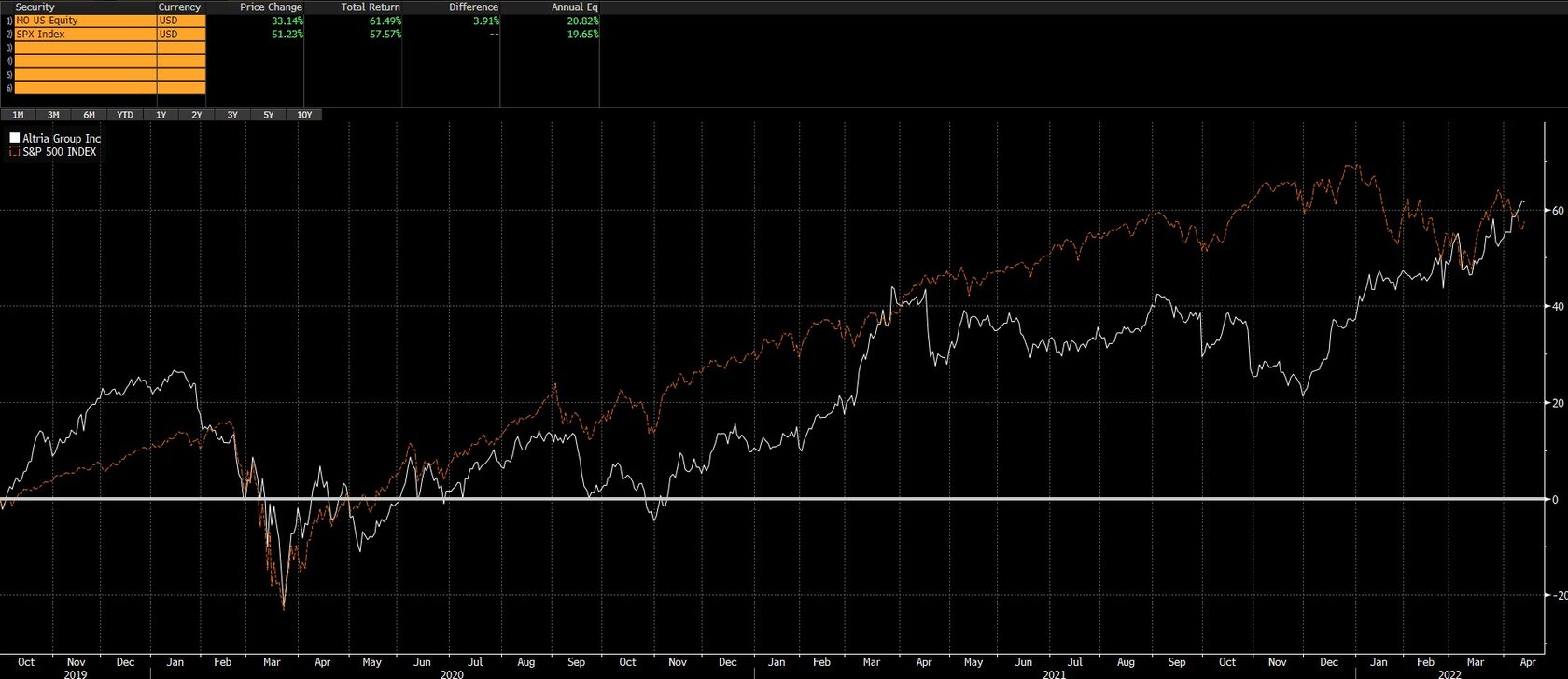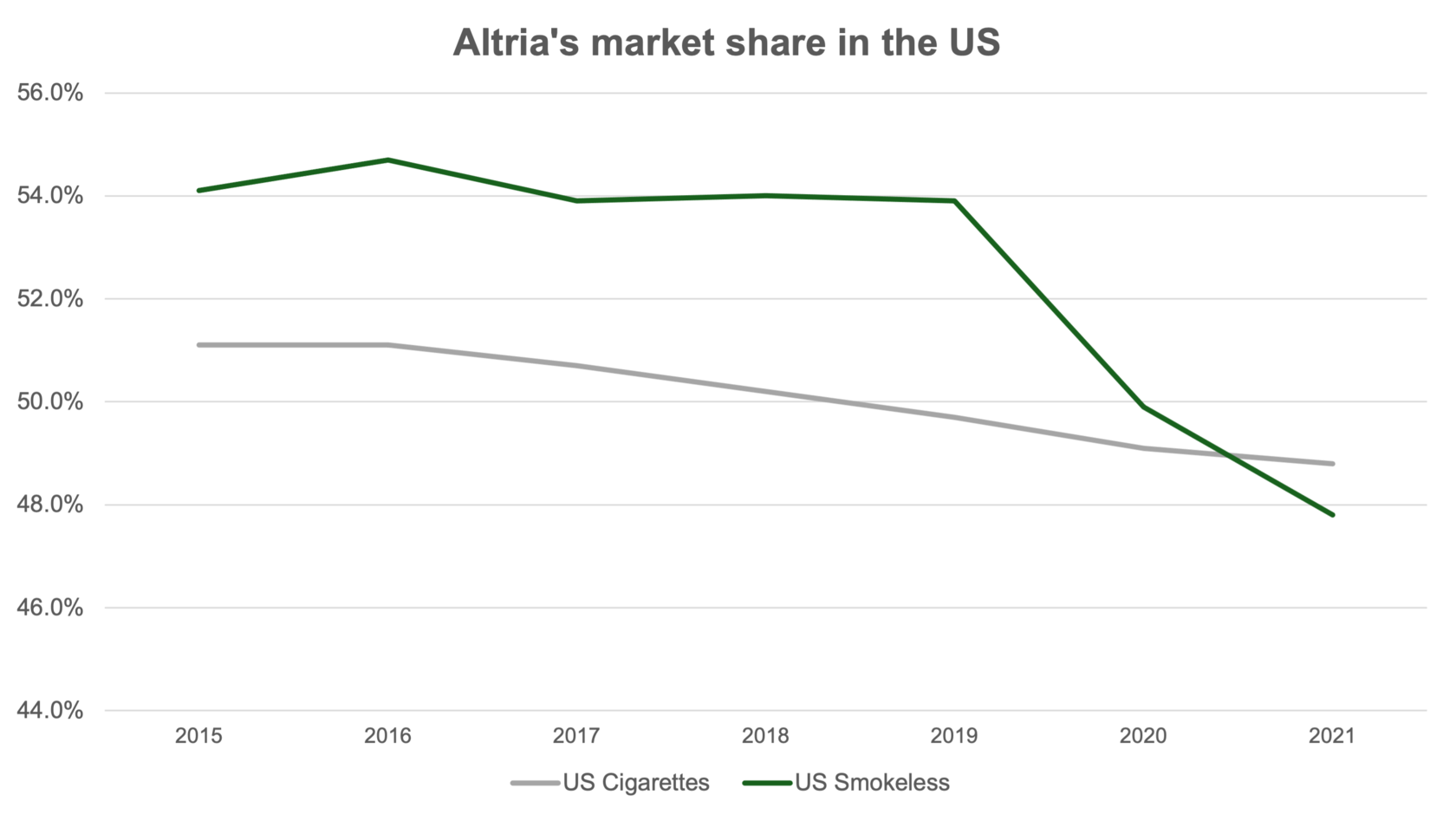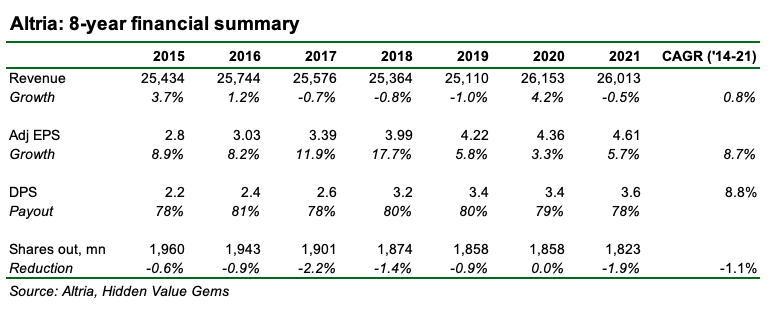Current share price: $55
Shares out: 1,817.2 million
Market Cap: $99.9bn
Net Debt: $23.5bn
EV: $123bn
PE: 11.3x
Dividend yield: 6.5%
Summary
I revisit my Altria investment which I made in autumn 2019. My total return (including dividends) is over 60% (slightly ahead of the S&P 500). I see much lower return potential in the future but still prefer to keep the stock in the portfolio as a potential inflation hedge and because I don’t see better alternative opportunities to deploy cash at the moment.
My original thesis
I first purchased Altria in October 2019 at an average $41 price as a turnaround case with an attractive 10% shareholder yield (dividend + buyback) and several free options. In late 2018, Altria acquired a 35% stake in a leading e-cigarette maker JUUL for $12.8bn and paid a $2bn bonus to its employees. This turned out to be probably the worst deal in Altria’s history as the company overpaid for the business, which had just $1.5bn in revenues although growing rapidly. Following the acquisition, the regulator introduced significant restrictions on vaping, which significantly limited JUUL’s growth potential and extended its losses.
The stock collapsed almost 50% from its peak of $77 in 2017 to $40 in September 2019.
Altria Share Price Performance ($)

Here are five specific reasons I decided to buy Altria:
1. Great business economics. Altria’s gross profit was almost 50%, operating and net margins - at 40% and 35%. The company spent just $238mn on capex in 2018 (and less than $200mn before that), while its operating cash flow was a healthy $8bn. Its capital intensity (capex-to-sales ratio) is less than 1%.
2. Attractive industry structure. US tobacco market is practically a duopoly, with over 80% of the market controlled by Altria and British American Tobacco. Altria accounts for 50% of the market, with its single Marlboro brand share of 40%. Getting new products into the market requires FDA approval, a rigorous regulatory process. Besides, with practically a ban on mass advertising of traditional cigarettes in the US, new players cannot reach out to consumers. This creates high barriers to entry and supports the robust economics of Altria.
3. Pricing power. I expected Altria to have strong pricing power (the ability to raise prices without losing market share). In addition to its strong market position (50% market share), smoking is highly addictive, making people who smoke much less sensitive to price inflation. So even if volumes were declining, I thought that Altria would more than offset that with higher prices.
4. Valuation. I paid 9.7x PE for Altria in 2019 and expected to earn a dividend yield of 8.2%. Dividends have increased by 50% during the past five years (2014-2018). On top of this, the company spent $1-3bn on share repurchases which increased shareholder yield to about 11% (Dividends + Buyback / Market Cap).
5. Hidden assets. In addition to the core cigarette business, Altria had several investments that were not fully consolidated in its accounts. As a result, reported earnings did not reflect the value generated by those investments.
- 10.1% interest in Anheuser Busch, the largest beer company globally, with a market value of $13.6bn ($135bn market cap in 2019)
- 45% interest in Cronos, one of the leading Canadian cannabis producers which was worth c. $3bn at that time (the market cap was over $6bn)
- 35% stake in JUUL. While the market was focused on how expensive the deal was, I thought there was some value in the asset, while the $12.8bn purchase price was the sunk cost.
The company also had two other business lines, which were consolidated, and thus reflected in profits. However, they had a more favourable dynamic (rising demand), unlike the core cigarettes operations. These businesses were smokeless tobacco and wine, which collectively contributed 17% to the company’s operating income. As they enjoy a better demand growth and much less regulatory pressure, the earnings stream of those two businesses could be valued using a higher multiple compared to the traditional cigarette segment.
So, to sum up, I thought that by buying Altria in autumn 2019 after a 50% collapse in the share price, I am getting an 8% dividend yield with a number of options to unlock more value (e.g. sale of a 10% stake in Anheuser Busch, achieving profitability at JUUL).
Subsequent performance
Altria looked like a disappointing investment to me as its share price lagged the market. Even during the sell-off in March 2020, it did not hold up and fell with the rest of the market. Not something you expect from a defensive, high dividend yield stock, especially as many expensive growth companies did much better. However, if you add the dividends that Altria continued to pay quarterly throughout my holding period, the total shareholder return is almost 61% (on top of 33% price appreciation).
If dividends are included, then Altria’s shares have outperformed the S&P 500 since October 2019. The index has increased by 58% over the same period.
As you can see from the chart below, 2021 was a pretty tough year as Altria was lagging behind the index for most of the time, and at some point, it was as much as 40% behind the index.
Altria Total Shareholder Return vs S&P500

Dividend collected: $8.8 (+21%)
Valuation multiple: from 8.2% dividend yield to 6.5% dividend yield (+25%)
Dividend growth: +7.1%
Total return: 53%
The difference between Bloomberg calculated returns (+61%) and my calculations (+53%) is due to the assumption that Bloomberg makes about collected dividends. It assumed that dividends were reinvested, while I assumed they remain cash with zero returns.
The main conclusion from this analysis is that the price for the business (which I estimate as a dividend yield) has accounted for almost half of total returns (25%).
Going forward
After following Altria for almost three years now, I think I may have been a little too optimistic on some points related to regulation, competition and growth potential.
Regulatory headwinds have been much stronger, putting pressure on the legacy cigarette business and the development of new products (e.g. vaping). Besides, there is a solid social trend favouring a healthy lifestyle.
Competition in the non-smoking segment remains very strong, with both small and global players offering alternative products.
Future returns from owning Altria will likely be lower
If you buy and sell a business for the same valuation multiple (e.g. 10x PE or 8% dividend yield), then your return from owning the stock equals the sum of a dividend yield and the growth of that dividend. In the case of Altria now, it is a 6.5% dividend yield and about 5-6% annual growth, which equals 11.5-12.5% total shareholder return, significantly less than the 20% annualised return achieved since October 2019.
Despite this, I prefer to keep Altria's position for now. The two key drivers for such decisions are:
- Company’s ability to pass on inflation
- Alternative opportunities to switch from Altria
Selling the stock now and paying a capital gain tax would leave me with cash that will lose its purchasing power over time. If I reinvest it into another business, I have to make sure it generates better returns. Returns have to be high enough to compensate me for the tax I would pay after selling my Altria position.
Inflation hedge?
As for inflation, in theory, Altria has a good chance to pass the rising inflation to consumers due to its 50% market share, strong margins, low capital intensity and a very loyal consumer base. However, it is not going to be easy. Consumer income was boosted by a one-off COVID-related support programme in the US. Lower mobility also reduced options for consumer spending and indirectly benefited tobacco consumption.
The big question is whether now, faced with the rising cost of living, especially fuel prices, consumers would maintain their spending on tobacco or whether they would cut back.
WSJ has recently published an article arguing that inflation will negatively impact tobacco companies. Most smokers are in a low-income category and are more sensitive to rising fuel prices than wealthier groups. Besides, 60% of cigarettes are sold at fuel stations. Higher prices at the pump discourage impulse spending in gas station convenience stores. Even if total tobacco consumption does not fall too much because of inflation, consumers could trade down, which would negatively impact sales of premium brands like Marlboro (Altria) with a consequent impact on the bottom line (Marlboro is a higher margin product than discount cigarettes).
The company is scheduled to publish its first-quarter results on 28 April, and I am keen to see what impact inflation will have on its performance.
Notably, the management of Altria has already seen some negative impact from inflation earlier this year. This means that the guidance they provided (4-7% EPS growth in 2022) should reflect some inflationary pressure and a high base effect of 2020-2021. The risk, of course, is that inflation has significantly accelerated after the call with the rising energy prices, which management could not have fully anticipated. I will view it positively if they deliver growth at the lower end of the guidance range. The company has some leeway with regard to R&D and marketing expenses, so perhaps in a weaker macro environment, they could adjust their spending plans.
This is what the CEO, Billy Gifford, said at the latest earnings call on 27 January 2022:
“Now, as we start seeing some of those [economic] pressures put pressure or decrease the discretionary spend of some of our consumers, you see the more price-sensitive adult smokers moving back to discount brands, and I think that would be expected. We believe that the current share of discount brands is at the high end of historical norms. Still, we do expect quarterly fluctuations in share to continue until the economy begins to stabilise from the pandemic."
"I think, overall, from a pricing standpoint, you recall the four factors that we look at to make pricing decisions: 1) strength of the brand, 2) the economic health of our consumers, 3) the demographics or relevancy of the brands across the various age cohorts and 4) corporate objectives. When you think about the strength of the brand, I would remind you that Marlboro has over 90% loyalty and that I think has shown through the eight quarters of stability.”
Limited growth potential
One other risk of holding Altria for too long is the gap between a flattish top line and continued growth in earnings. Since 2014, Altria’s sales have grown on average by 0.8%, while its net income (adjusted for one-offs) has increased by 8.7%. This can be achieved temporarily as the company raises margins by cutting costs and growing the share of high-margin products (non-smokable) in its sales mix. A tax cut in 2017 also provided a one-time boost to earnings.
Related to this, Altria’s market share has actually been gradually declining (see chart below). I think this limits company’s ability to raise prices further (which also means that its earnings growth may be slowing down).

The company’s dividend payout ratio is almost 80% which means that the company allocates just 20% on investing in the business. Virtually all these ‘investments’ are spent on buying back shares that help grow EPS but only at a modest pace. The company cannot materially boost dividends, whose growth is capped by organic growth of about 5%.
Regulation has continued to remain quite unfavourable, although this was partially expected and given the past performance, I expect a limited impact on Altria’s business in the future. It is also fair to say that its growth potential will remain very modest due to strict regulations.
Finally, as for ‘Hidden assets’ - they largely remain under monetised. I think prospects of getting any tangible returns from them are pretty low. Anheuser Busch’s performance has been lacklustre (both its stock and business performance). Same for Cronos.
To conclude, I would not buy Altria with ‘fresh’ money today, and it is my top candidate for switching into some better opportunities. However, I will keep the position for now mainly as an inflation hedge.
Financial summary



Source: Altria Q4 2021 presentation
Did you find this article useful? If you want to read my next article right when it comes out, please subscribe to my email list.


